Voice search has quickly become a cornerstone of modern SEO — and it’s not slowing down anytime soon.
In fact, in the U.S. and U.K., around 28% of consumers use voice assistants every day, showing just how ingrained this technology has become in daily life.
If your business isn’t optimizing for voice search, you could be missing out on valuable traffic and potential customers.
In this guide, we’ll explore eight powerful strategies to help your website stand out in voice search results — from using conversational keywords and structured data to improving accessibility and page performance.
1. Focus on Conversational, Long-Tail Keywords
Unlike traditional typed queries, voice searches tend to sound more natural and conversational.
For example, instead of typing “best sushi Chicago,” a user might ask, “Where can I find the best Japanese restaurant in downtown Chicago?”
To align your content with these natural patterns:
- Target long-tail keywords that mirror real-world speech.
- Include question-based phrases starting with “who,” “what,” “where,” “when,” and “how.”
- Use tools like AnswerThePublic, People Also Ask, and Google’s autocomplete to discover what your audience is actually asking.
Example:
A pet grooming business could optimize for queries such as, “How often should I groom my golden retriever?” or “What’s the best dog grooming service near me?”
Creating pages that directly answer these types of spoken questions increases your likelihood of ranking in voice search results.
2. Target Position Zero (Featured Snippets)
When someone asks their voice assistant a question, it often reads the answer from a featured snippet, also called position zero.
Earning this placement boosts visibility and credibility instantly.
To optimize for featured snippets:
- Write concise answers (40–50 words) to common questions.
- Use lists, bullet points, and headings for clarity.
- Include step-by-step instructions for “how-to” topics.
Example:
A financial planning firm could create a blog titled “How to Start a Retirement Plan in Your 30s.”
By structuring the content with clear steps and short explanations, the business increases its chances of being read aloud by Google Assistant or Alexa.
3. Strengthen Your Local SEO Presence
Nearly half of all voice searches are local, often beginning with phrases like “near me” or “closest.”
To optimize for local voice searches:
- Claim and verify your Google Business Profile (GBP).
- Keep your name, address, and phone number (NAP) consistent across all platforms.
- Gather authentic customer reviews and respond to them.
- Use location-based keywords on your site and create dedicated city or neighborhood pages.
Example:
A local HVAC company in Denver could add pages like “Furnace Repair in Highlands Ranch, CO” or “Air Conditioning Services in Aurora, CO.”
Adding LocalBusiness schema and embedding a Google Map can further help search engines connect you with nearby voice queries.
4. Improve Your Website Speed
Speed is everything — especially for voice searches. Users expect instant answers, and Google prioritizes fast-loading websites in both mobile and voice search results.
- Compress large images.
- Enable browser caching.
- Minify CSS, JavaScript, and HTML files.
- Reduce redirects and use a reliable hosting provider.
Example:
A fashion boutique with an image-heavy website could improve performance by using next-gen image formats like WebP, optimizing code, and implementing a content delivery network (CDN). These improvements not only enhance user experience but also increase voice search ranking potential.
5. Use Structured Data (Schema Markup)
Structured data, or schema markup, helps search engines understand your content contextually — making it more likely to appear as a voice-read answer.
Key schema types for voice SEO include:
- LocalBusiness – for local companies.
- Product – for eCommerce listings.
- FAQPage – for frequently asked questions.
- Organization and Service – for general business information.
Example:
A local fitness studio can apply schema that lists class schedules, pricing, and location details.
When someone asks, “What yoga studios are open near me right now?” Google can use this structured data to deliver your business as a top voice result.
6. Create Voice-Friendly, Readable Content
Voice-friendly content should sound natural when read aloud.
That means clear language, short sentences, and simple structure.
Here’s how to make your content more voice-ready:
- Write at an 8th-grade reading level for clarity.
- Use H2 and H3 headers to organize ideas.
- Keep paragraphs 1–2 sentences long.
- Incorporate FAQs that directly answer user questions.
- Use conversational tone — write how people speak.
Example:
A travel agency could create an FAQ page with questions like “When is the best time to visit Hawaii?” and “How much does an all-inclusive trip cost?”
These straightforward, natural-language answers work well for both text and voice search.
7. Prioritize Website Accessibility
Voice search overlaps with accessibility — both aim to make information easier to reach.
Improving accessibility helps not only users with disabilities but also voice assistants better interpret your content.
Accessibility best practices include:
- Adding alt text for all images.
- Using descriptive anchor text for links.
- Providing transcripts for audio and video content.
- Structuring content with semantic HTML tags.
Example:
A cooking blog that includes transcripts for video recipes and descriptive labels for each step helps both visually impaired users and voice assistants read and interpret the content accurately.
8. Experiment with Emerging Voice Technologies
As voice technology evolves, new opportunities are appearing for marketers and business owners.
Consider integrating or testing voice-specific features such as:
- Google Assistant and Alexa integrations (like recipe or service skills).
- Speakable markup to tell Google which sections of your content are best suited for voice playback.
- Voice commerce optimization on platforms like Amazon, Target, or Walmart.
Example:
An online skincare store could optimize its product listings for voice commerce by including descriptive language and FAQs such as, “Which moisturizer is best for dry skin?”
This approach helps products surface in smart-speaker shopping results.
Get Your Business Voice-Search Ready
Adapting your SEO strategy for voice search isn’t just a trend — it’s a necessity.
By focusing on conversational keywords, structured data, accessibility, and technical performance, you can ensure your website is well-positioned for the growing number of voice-driven searches. The future of search is conversational — and by preparing now, your business can stay ahead of the curve and connect naturally with the way people search today.






